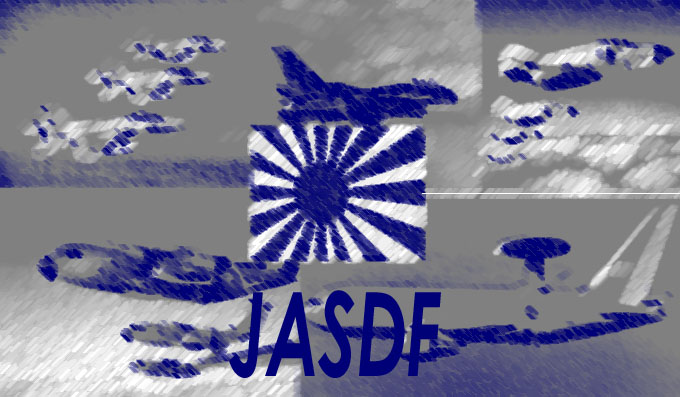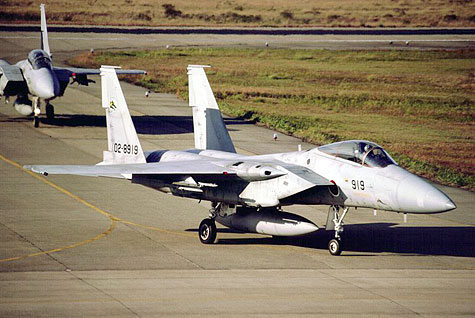|

| The establishment of the Japanese Air Self Defence Force as
we know it took place on July 1st 1954.During the second half of the
nineteen fifties the NKJ expanded to a sizeable air force with the
backbone being formed by 180 US built and 300 Mitsubishi built F-86's.In
1962 a new era started for the NKJ when the Lockheed F-104J Starfighter
was selected as the successor to the F-86 Sabre in the air defence role.
Between 1962 and 1967 210 Mitsubishi F-104J's and 20 F-104DJ's were
delivered equipping seven squadrons. |
 |
The seventies saw the development and introduction of a
number of aircraft types which still can be seen on the inventory such as
the Kawasaki C-1 which succeeded the ageing fleet of C-46's as well as the
Mitsubishi F-1 and T-2 which replaced the last F-86F's in the close air
support and advanced training role. In 1977 the F-15J was already selected
as the successor to the F-4EJ fleet for which deliveries were not even
completed by that time ! |
| The nineties saw the retirement of the fleet of T-33's and
T-1's by Kawasaki T-4's, the KV 107 by the UH-60J, the Mu-2 by the U-125
and the Beech 65 by the U-4 Gulfstream. At this time the Mitsubishi F-1
and T-2 is progressively being replaced by the Mitsubishi F2. |
Aircraft of the JASDF :
Fighters/Attack :
- F-15J Strike Eagle



|
The F-15, the commanding fighter built for the
U.S. Air Force, was developed by McDonnell Douglas with its first flight
in 1972. In Japan, it was introduced into the Air Self-Defense Force,
and manufactured and licensed as the F-15J, with MHI as the primary
contractor. Since 1980 exactly 213 fighters of this type have been
purchased. Apart from a dozen two seaters, all Eagles of the JASDF have
been produced under license at Mitsubishi. Low production rates pushed
the price of an individual aircraft up to 180 million DM. Since there is
no replacement in sight for the F-15J, the Air Force is planning a
modernisation program, which will include improving the radar and the
main computer. Additionally an improved ECM system and FLIR-Sensor will
be fitted. The maiden flight of a prototype is planned for 2001.
|
- F-4 Phantoms
 |
The Japan Air Self-Defense Force received 154
Japanese F-4EJ Phantoms including the final Phantom built worldwide. All
Japanese F-4EJs are optimized for the air defense role and used to equip
six interceptor squadrons. In total 96 F-4EJs have been upgraded to the
F-4EJ "Kai" (new) standard and will serve the JASDF well into
the next millenium. For recce 14 RF-4EJs have been received, later boosted
with 17 F-4EJs converted to reconnaissance Phantom as RF-4EJ-Kai. |
- Mitsubishi F-1
 |
The Mitsubishi F1 attack aircraft, which is similar in
configuration to the Jaguar, is the combat version of the T-2 trainer. The
rear cockpit of the T-2 is faired over with the space used for additional
fuel. Other modifications include the addition of two wing pylons and a
fuselage pylon, and the 20mm Vulcan cannon of the T-2A armament trainer
along with combat avionics. The F-1 is a capable attack aircraft though
with relatively short range, and can be used in interception missions
carrying the AIM-9 missile. A total of 77 aircraft were built. |
- Mitsubishi F-2


|
The F-2 support fighter aircraft for the Japan Air Self Defence Force (JASDF)
is the result of a joint Japan and USA development programme.The Japan
Defence Agency plans to procure a total of 130 F-2 aircraft, with
production deliveries from the year 2000 to beyond 2010. The requirement
is for 83 single-seater and 47 two-seater aircraft. The F-2A is the
single-seat version and the F-2B is the two-seat version.Flight trials of
the prototypes were successfully completed by 1997, and the aircraft
entered production in 1998. The first production aircraft was delivered to
the Japanese Defence Agency in September 2000, and by the end of March
2001, 18 F-2 fighters had been delivered.The cockpit is equipped with
three multifunction displays, including a liquid crystal display from
Yokogawa.The aircraft is capable of deploying the Raytheon AIM-7F/M
medium-range Sparrow air-to-air missile, the Raytheon AIM-9L short-range
Sidewinder and the Mitsubishi Heavy Industries AAM-3 short-range
air-to-air missile. |
Transport Aircraft :
- B-747 Boeing
 |
Mainly used in the JASDF for VIP duties. 2 B-747 are in
service in the JASDF. |
- Kawasaki C-1


|
The Kawasaki C-1 was designed to replace the C-46. The first
prototype flew on November 12, 1970. The second prototype flew on January
16, 1971. The first pre-production aircarft flew in 1972. The second
pre-production aircraft flew in 1974. The first production C-1A (number
48-1008) flew in December 1974. By 1981, a total of 31 C-1A had been
delivered. The C-1KA, featuring a redesigned nose, upgraded avionics,
first flew in 1985. The EC-1 variant carries surveillance equipment. |
- C-130J Hercules
 |
The Lockheed Martin C-130 is the JASDF
principal tactical cargo and personnel transport aircraft, and the C-130J
Hercules is the latest model, featuring a glass cockpit, digital avionics
and a new propulsion system with six-bladed propeller. Improvements built
into the C-130J, which entered production in 1997, have enhanced the
performance of the aircraft in terms of range, cruise ceiling time to
climb, speed and airfield requirements |
- C-47J Chinook
 |
The CH-47D Chinook helicopter carries out
transportation of troops, artillery, supplies and equipment to the
battlefield. Other roles include medical evacuation, aircraft recovery,
parachute drop, search and rescue, disaster relief, firefighting and heavy
construction. |
Support Aircraft :
- E-2C Hawkeye


|
The fighters are supported by 13
Northrop-Grumman E-2C Early Warning Aircraft, which are stationed in
Misawa. The primary role of the E-2C Hawkeye aircraft
supplied by Northrop Grumman is as an all weather airborne early warning
aircraft to the naval task force. From an operating altitude above 25,000
feet, the Hawkeye warns the naval task force of approaching air threats
and provides threat identification and positional data to fighter aircraft. |
- Boeing E-767 AWACS
 |
The Boeing 767 AWACS Airborne Warning and
Control System has been selected by Japan to carry out airborne
surveillance and command and control (C2) operations for tactical and air
defence forces. The surveillance system is based on a flexible, multi-mode
radar which enables AWACS to separate maritime and airborne targets from
ground and sea clutter radar returns.Following studies of the most
suitable follow-on aircraft for the AWACS mission, Boeing announced in
December 1991 that it would offer a modified 767 jet as the platform for
the system.All four aircraft entered service with the Japanese Air
Self-Defense Force (JASDF) in May 2000.The AWACS radar provides a
360-degree view of the area. At operating altitudes it can detect targets
more than 320km away. |
- UH-60J Rescue Helicopter
 |
The Air Self-Defense Force (JASDF) UH-60J is a rescue
helicopter based on the U.S. Army multi-purpose helicopter, the UH-60A
"BLACK HAWK".UH-60J (JASDF/JMSDF) is equipped with infrared
night vision, and weather radar navigation systems for better mobility |
Sources :
 | JASDF Homepage |
 | Scramble : JASDF |
Visit the Site's Forum ''World's
Armed Forces Forum''
| The pictures and text displayed
on this site have been found by me on the Internet or given to me by
visitors. If these are copyrighted, let me
know and I will remove them.
|
|